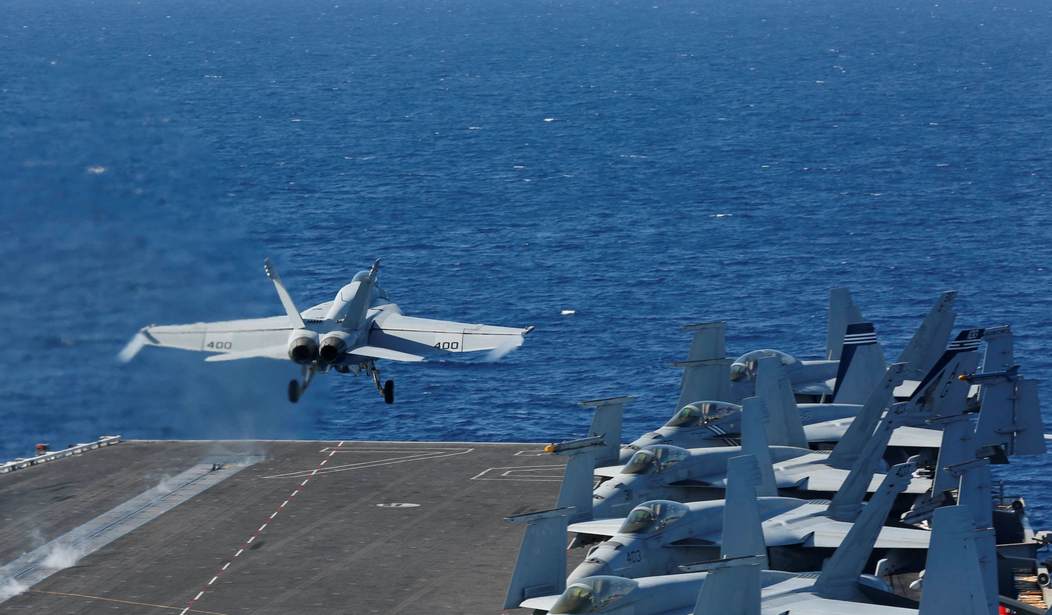The U.S. deployment of a carrier strike group and air force bomber unit to deter Iran from a planned attack on American forces was reported to be in response to a new threat. CNN’s Barbara Starr wrote: “US officials tell me the threats from Iran included ‘specific and credible’ intelligence that Iranian forces and proxies were targeting U.S. forces in Syria, Iraq and at sea. There were multiple threads of intelligence about multiple locations, the officials said.”
But the U.S. and Iran have been struggling in the twilight for years though it has never received much attention from the press. Only last month the administration imposed some belated sanctions for hundreds of casualties inflicted on U.S. forces over the years.
The Trump administration has designated Iran’s Islamic Revolutionary Guard Corps (IRGC) as a foreign terrorist organization. The designation is long overdue, yet many Americans may not know that the IRGC has been a leading killer of U.S. troops.
According to new information released last week by the administration, Iran was responsible for the deaths of over six hundred U.S. service members in Iraq between 2003 and 2011, a significant percentage of U.S. casualties in the conflict. That statistic does not include the thousands of Americans injured in Iraq due to the actions of Tehran and its proxies.
The new administration’s policy of new sanctions may have stirred up a hornet’s nest. “It is the first time that the United States has designated a part of another government as an FTO. This action underscores that the Iranian regime’s use of terrorism makes it fundamentally different from any other government. Iran employs terrorism as a central tool of its statecraft; it is an essential element of the regime’s foreign policy.”
“We see you” and removing traditional self-restrictions may be destabilizing. It ruins the game that was formerly played.
As with Venezuela, the new administration is increasingly employing its own brand of non-kinetic tactics to Iran. After all, Tehran’s hybrid warfare has long extended to the Americas. “IRGC Quds Force officers have worked with diplomatic cover at Iran’s large embassy in Caracas, providing intelligence and other assistance to the Venezuelan government, according to Pentagon reports … played a key role in dismantling a coup plot against Maduro last year … the arrest of almost 100 army officers … organized paramilitary ‘colectivos’ to silence the opposition, arming them with Iranian-made 5.56-mm compact versions of the Russian AK-47.”
That makes the choice of a carrier strike group and bomber force to deter Tehran all the more puzzling because the IRGC rarely strikes openly. Its Quds Force carries out “unconventional warfare and intelligence activities … extraterritorial operations [involving] non-state actors … that include Lebanese Hezbollah, Hamas and Palestinian Islamic Jihad in the Gaza Strip and the West Bank, Yemeni Houthis, and Shia militias in Iraq, Syria, and Afghanistan.” It has shown itself willing and able to strike directly back at U.S. interests from the shadows such as when it kidnapped and killed four American soldiers in retaliation for a U.S. raid on the Iranian liaison office in Irbil Iraq.
What may have brought things to a head are Tehran’s ambitions in Syria. The former national security adviser of Israel argued that Iran, through Islamic Jihad, is trying to provoke Israel into launching a Gaza ground operation so that Tehran can launch an operation in Syria.
Iran, through Palestinian Islamic Jihad – its proxy in Gaza – is behind the current escalation in the South, former national security adviser Yaakov Amidror said on Sunday. … Hamas, Amidror said, was “dragged” into the current escalation by Islamic Jihad. …
Islamic Jihad, unlike Hamas, is a completely owned and operated Iranian subsidiary, Amidror said. “It was established by Iran, financed by Iran, and does what Iran wants it to do.” … Iran’s interest, Amidror said, is for Israel to embark on another major operation in Gaza, freeing up Tehran to do what it wants unhindered in Syria.
The Iranian idea, he said, is that “Israel will be busy focusing on Gaza and not have enough energy to deal with the building up of an independent war machine in Syria.”
Whatever that mysterious operation may be, American troops are likely in the line of fire. “The U.S. has some 2,000 troops in Syria, where Iran and its proxies have a physical military presence; 5,000 security forces in Iraq, where the Islamic Republic remains an influential player; and 14,000 troops in Afghanistan, where Tehran has made common cause with the Taliban in the fight against ISIS. Iran has the means to escalate tensions in any of these countries,” wrote the Atlantic. Echoing Barbara Starr’s information, it said the big threat was probably in the Middle East:
Iranian proxies could also fire rockets against U.S. bases in Iraq and Syria. Last September, Iranian-backed militias struck the U.S. consulate in Basra, forcing its evacuation, and the U.S. embassy in Baghdad. And in the Persian Gulf, U.S. officials have in recent years cited unsafe or harassing maneuvers by Iranian drones and boats against U.S. planes and ships—in 2016, the Islamic Revolutionary Guard Corps briefly captured 10 U.S. sailors at sea.
“The U.S. is now signaling that it is prepared to retaliate” by emphasizing that it does not distinguish between the Iranian government and its militia proxies, Michael Knights, an expert on the region at the Washington Institute, a think tank that studies the Middle East, told us.
Not everyone thinks that being able to see and respond to Iran’s shadowy onslaught is a good thing. It might lead to an escalation far more destructive than the low-level conflict has been so far. As one of the Atlantic’s experts said: “the problem is, given that there are no off-ramps, and no channels of communication between the two countries, the risks of a confrontation quickly spiraling out of control are quite high.”
The Obama administration’s emphasis on containing confrontation with Tehran is wilting under the Trump policy of paying them back in their own coin. The New York Times wrote, “tensions escalated between the United States and Iran on Monday as the Trump administration accused Iran and militias that it backs of threatening American troops, and Iran signaled it might soon violate part of the 2015 nuclear deal it reached under former President Barack Obama.”
Taken together, the moves by both sides have brought relations between President Trump and Iran to a new low after a period of rapprochement that began in 2013 during the Obama administration.
The Trump administration has consistently sought to isolate Iran’s clerical government. One year ago, Mr. Trump withdrew the United States from the nuclear deal that was brokered with world powers, and in the last month alone moved to cut off Iran’s remaining oil exports and designated an Iranian military unit as a terror organization.
Iran’s expected suspension of some elements of the nuclear deal appeared to be a response to the aggressive American policies, which were underscored by the announcement of the U.S.S. Abraham Lincoln heading to the Gulf.
Hybrid warfare was supposed to be self-limiting What no one may have realized is that even low-level unconventional responses by a superpower could be so effective it could drive a foe to escalation. The IRGC, like Maduro, may never have anticipated the consequences of imitation.
Follow Wretchard on Twitter
Tipjar at wretchard.com
Support the Belmont Club by purchasing from Amazon through the links below.
Books/Eyewear:
The Safeguard of the Sea: A Naval History of Britain 660-1649, by N.A.M. Rodger. A companion volume to The Command of the Sea, also by Rodger.
Six Frigates: The Epic History of the Founding of the U. S. Navy, by Ian W. Toll.
One Small Step Can Change Your Life: The Kaizen Way, by Robert Maurer. An essential guide to kaizen – the art of making great and lasting change through small, steady steps.
Skyfaring: A Journey with a Pilot, by Mark Vanhoenacker. An exploration of the human experience of flight.
YIMI Polarized Sports Sunglasses/Day and Night Driving Glasses
The Last Job: “The Bad Grandpas” and the Hatton Garden Heist, by Dan Bilefsky. A gripping account of how a motley crew of six English thieves, several in their sixties and seventies, came out of retirement and nearly pulled off one of the greatest heists of the century.
For a list of books most frequently purchased by readers, visit my homepage.
Did you know that you can purchase some of these books and pamphlets by Richard Fernandez and share them with your friends? They will receive a link in their email and it will automatically give them access to a Kindle reader on their smartphone, computer or even as a web-readable document.
The War of the Words, Understanding the crisis of the early 21st century in terms of information corruption in the financial, security and political spheres
Rebranding Christianity, or why the truth shall make you free
The Three Conjectures, reflections on terrorism and the nuclear age
Storming the Castle, why government should get small
No Way In at Amazon Kindle. Fiction. A flight into peril, flashbacks to underground action.
Storm Over the South China Sea, how China is restarting history in the Pacific.










Join the conversation as a VIP Member